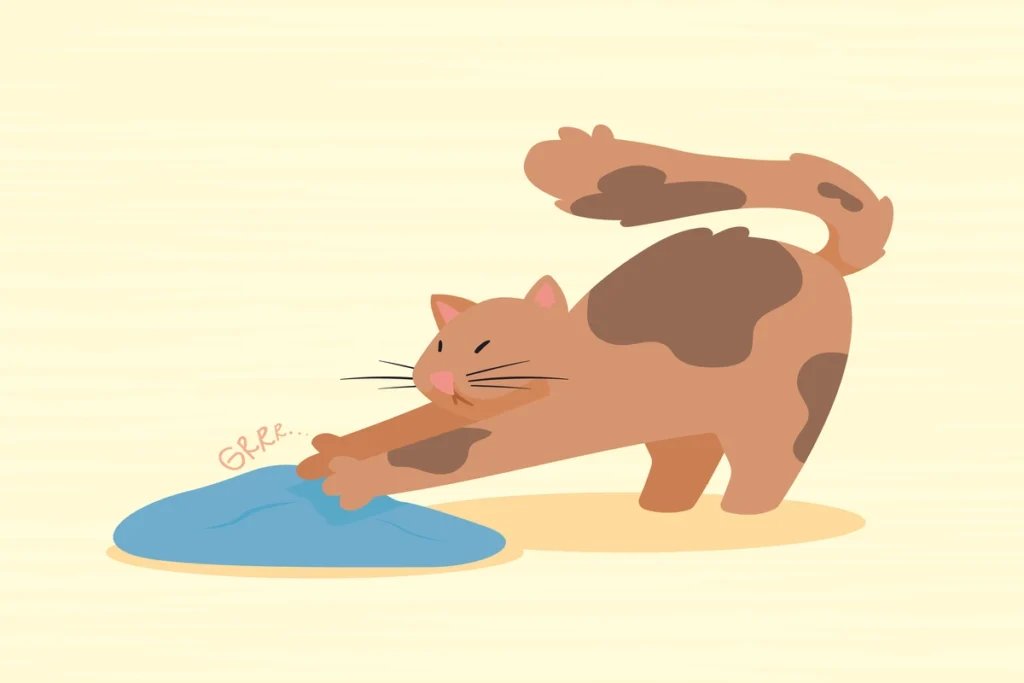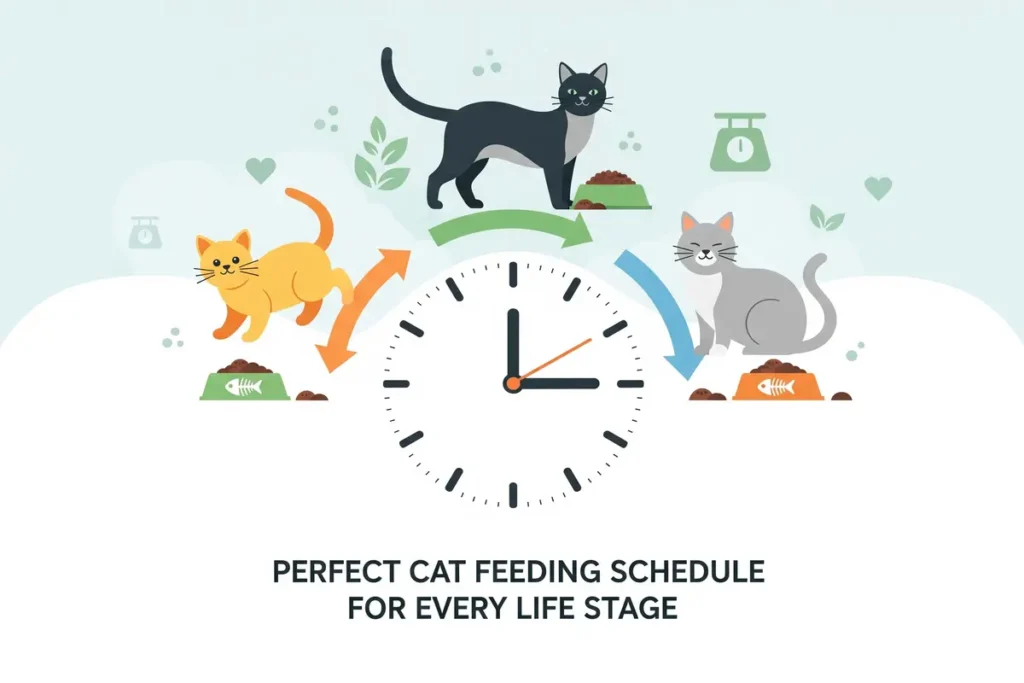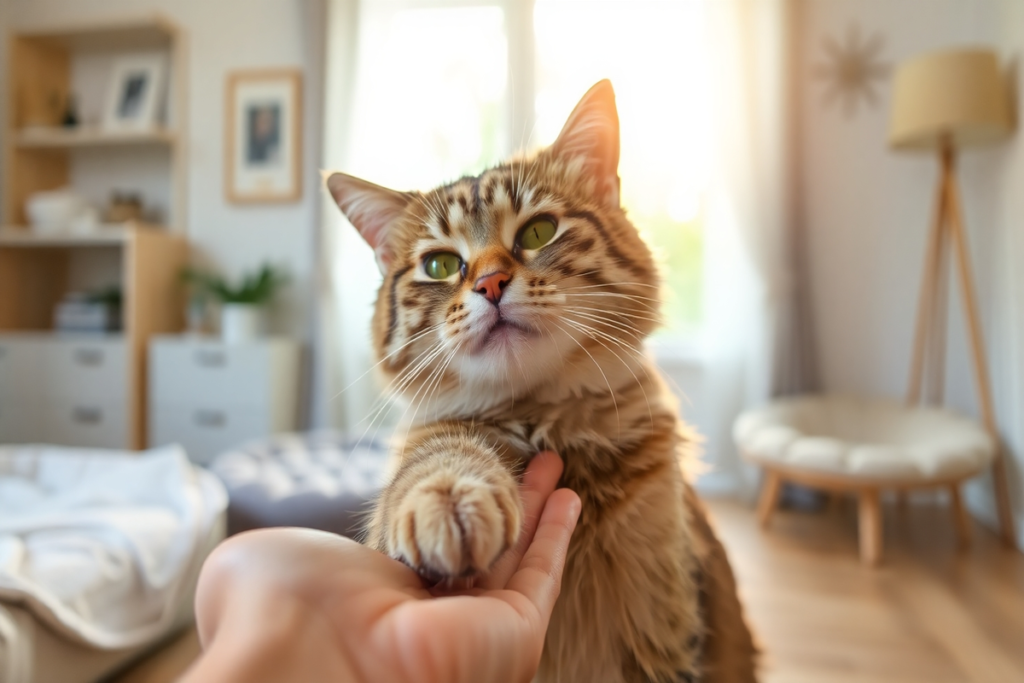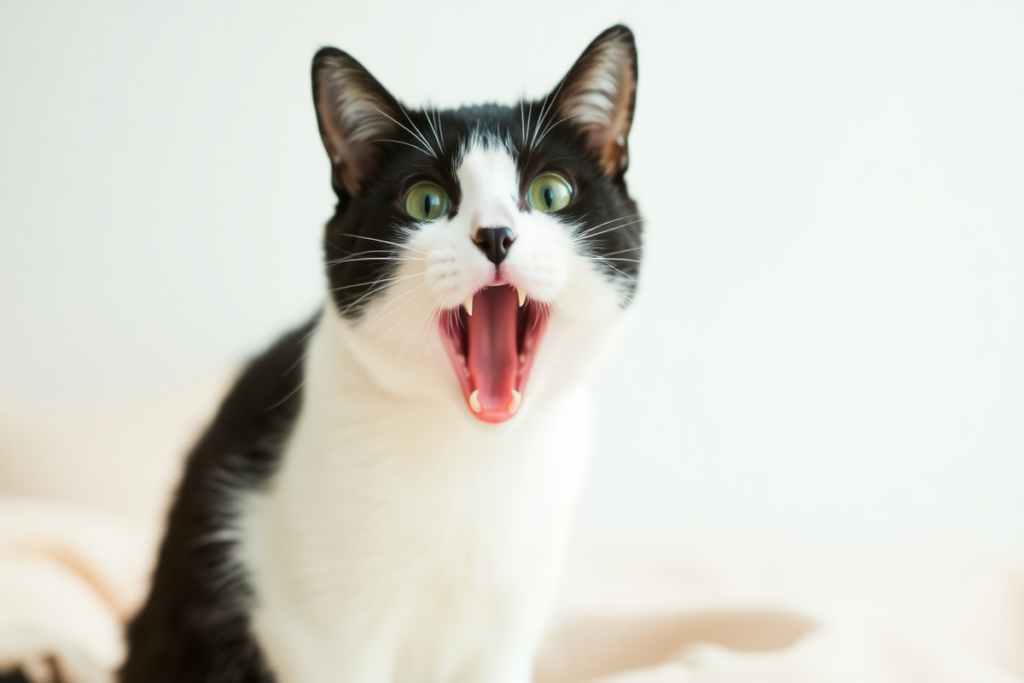Cat anxiety is a real emotional and physical reaction to situations in which a cat perceives a threatening situation that may appear harmless to the human eye.
Anxious cats exhibit behaviours such as hiding during storms, flinching at loud sounds, avoiding eye contact, shaking and quaking, and pacing the house when alone.
Cat anxiety is not a personality trait but a condition that affects many cats.
In this guide, I will help you recognize when your cat is showing signs of anxiety, determine the causes of anxiety, and, most importantly, how to calm an anxious cat with reliable, veterinarian-approved techniques.
Whether your cat is afraid of a veterinarian visit, loud noises, meeting new people, or is just anxious when you are out of the house, you will learn how to provide a calming environment, build their confidence, and improve their health and happiness.
Let’s help your anxious cat feel safe, secure, and loved from today.
What Is Cat Anxiety?
Cats can appear relaxed and calm but can be highly sensitive. Anxiety in cats is just a natural stress reaction to something they believe is threatening them, regardless of whether it is or isn’t. Sometimes, the signs are easy to spot, like bolting under a bed when you turn on the vacuum cleaner. Other times, it is hidden, like crouching low, flattening their ears, or spending hours hiding after an encounter they thought was scary that you never saw.
Anxiety in cats commonly begins at a young age, between 5 and 14 months old, and has the potential to worsen with age if left unattended. Anxiety could be triggered by an unfamiliar guest arriving in your home, loud noises, relocating to a new home, or even creating anxiety. It can significantly affect a cat’s emotional and physical health.
Let’s uncover the signs and symptoms you should pay attention to so that you can calm anxious cats using proven techniques.
Recognizing Anxiety Signs in Cats
Cats are excellent at hiding discomfort, making it challenging to recognize anxiety in them, but not impossible. Whether it is simply subtle changes or severe behaviors, the ability to see the clues of anxiety in cats is crucial to early intervention and long-term emotional well-being.
We will explore the mild, moderate, and severe signs of stress levels and then look at symptoms, both physical and behavioral, that pet parents should never overlook.
It’s essential to know the signs of a sick cat because many anxious behaviors (hiding, over-grooming, appetite changes, etc.) can mimic physical illness.
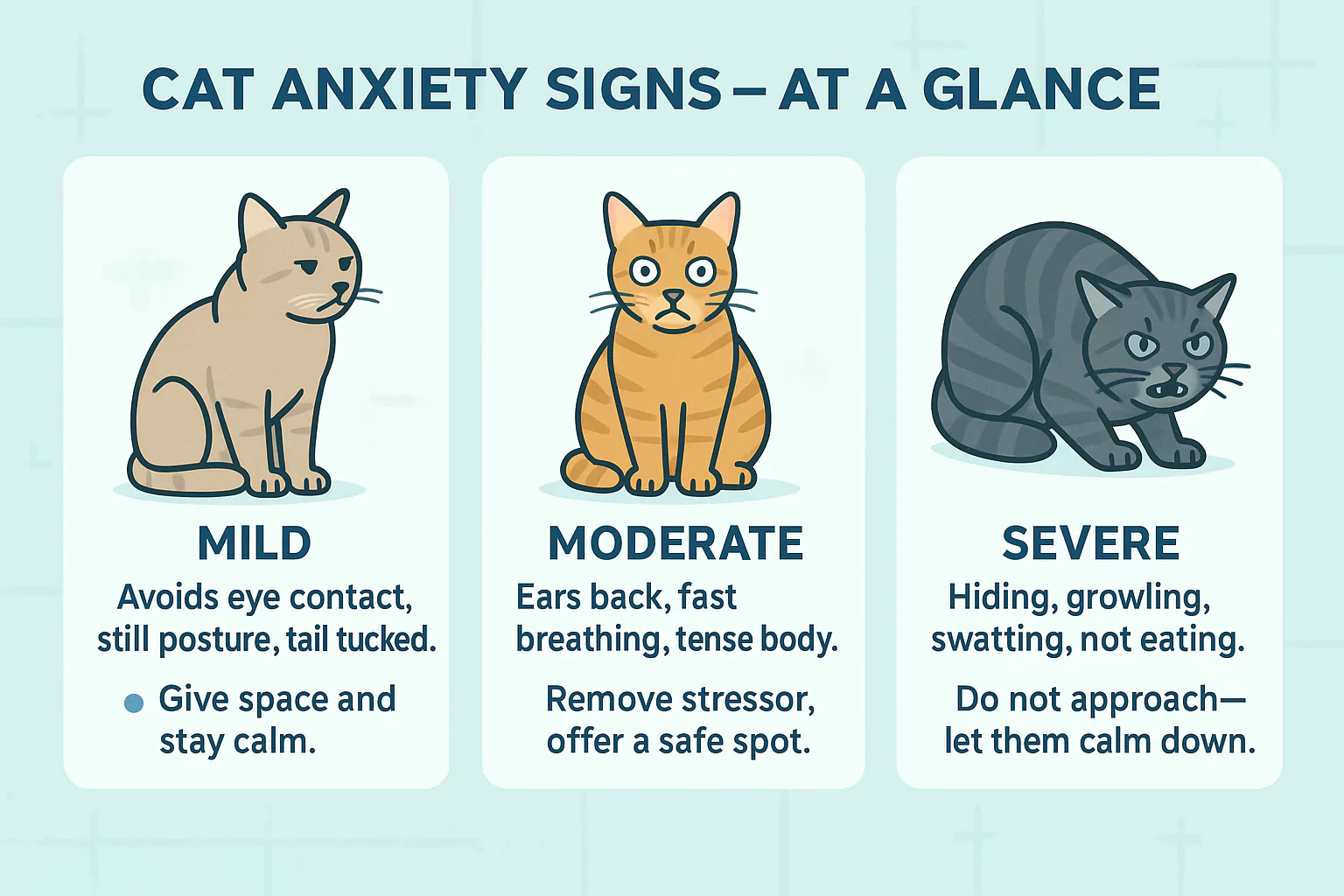
Mild Anxiety Signs
Your cat may not show noticeable anxiety at this point, but minor signs are there if you pay attention. Catching the anxiety in its early stages will allow you the best chance of calming it before it rises.
Look for these subtle signals:
- Avoiding eye contact
- Small shifts in body or freezing while in motion
- Tail tucked against the body
- Pupils slightly dilated
- Whiskers pulled back
What to do: Give your cat space, reduce noise, and whisper. If your cat approaches you, you should provide comfort on your terms.
Moderate Anxiety Signs
When anxiety grows, body language becomes more obvious. Your cat is now visibly uncomfortable and preparing for fight-or-flight mode.
Moderate anxiety may look like:
- Ears away from the sides of the head or tipped back
- More noticeable pupil dilation
- Breath fast or shallow
- Focus staring at a stressor
- Crouched body or leaning away
- Tail tightly curled
- Tense body posture
What to do: Removal of the stressor if possible; do not force any interactions. Provide a safe space, including a warm, cozy hiding space.
Severe Anxiety Signs
These are emergency signals. At this point, your cat truly believes they are in danger and may act like their only option is to protect themselves.
Severe anxiety signs include:
- Attempting to escape or completely freezing
- Fully dilated pupils
- Ears flat to the head
- Piloerection (fur standing on end)
- Arched back, or defensive posture
- Growling, hissing, swatting, or bites
- Destructive behaviors, such as clawing the furniture
- Refusing food or water.
What you should do: Do not try to hold, scold, or chase your cat. Back off and give your cat time to decompress in a quiet, confined space.
Physical Symptoms of Cat Anxiety
Anxiety isn’t limited to just being a mental issue; anxiety can affect the body of your cat. Symptoms that appear physical can be a sign of illness, but they are often because stress has become chronic and has affected the mind and body. Here are some indicators to watch for that have physical symptoms:
- Painting of trembling (even if the cat does not appear hot)
- Rapid heartbeat or fast breathing
- Vomiting or diarrhea for no medical reason
- Salivating or drooling excessively
- Stiffness of muscle or tightness of body
- Lethargy or sudden excitement
- Over-grooming, at times from the point of loss of hair
- Dilated pupils that do not return to normal fairly quickly
If there are physical symptoms, visit the veterinarian. Ensuring no underlying health issues are present is essential before diagnosing true anxiety.
Behavioral Signs of Cat Anxiety
Since cats can mask their fear, you might not see the trigger, just the emotional results. Sudden changes in behavior are big signs. Here are common behaviors caused by anxiety:
- Hiding under beds, furniture, or inside closets
- Freezing in place, ears back
- Tail tucked tightly or swishing
- Fluffing up, arched back, or running away quickly
- Scratching furniture, knocking things over
- Peeing or pooping outside the litter box
- Crying, excessive meowing, or pacing
- Clingy – always wanting to be with you
- Unprovoked aggression toward other pets or even humans
Did you know? Stress cystitis, a painful bladder condition caused by long-term anxiety, can lead to inappropriate urination and serious health issues.
Why Early Recognition Matters to Calm an Anxious Cat
The longer anxiety is left untreated or unaddressed, your cat’s mental health and physical health are at risk. Chronic stress can change your cat’s behavior for the worse and can weaken the immune system.
It shows why it is important to recognize signs of anxiety as they appear; from a flick of a tail to a growl from a hidden space, it could save your cat from undue suffering and a more enjoyable life that is less anxious.
Common Triggers of Anxious Cat
Understanding what could be triggering your cat’s stress is essential for not only understanding your cat’s anxiety but also for being able to keep your cat happy and emotionally healthy. Let’s figure out some of the most common forms of stress for your cat so that you can begin to recognize and minimize the triggers for your cat.
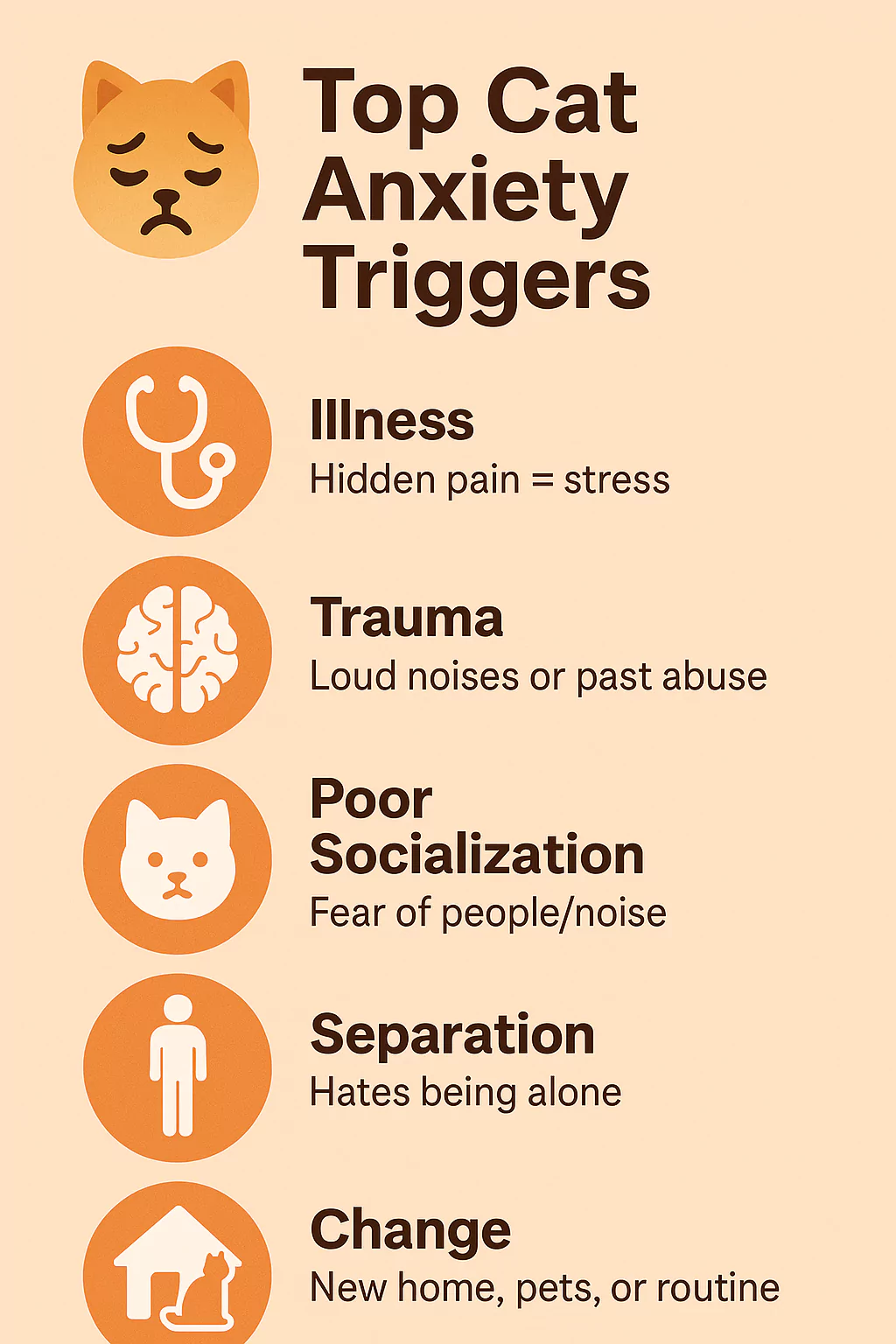
Hidden Pain or Health Issues
One of the most frequently overlooked causes of anxiety in felines is physical discomfort. Cats are instinctually conditioned to hide pain, so you might not realize anything is wrong until you see anxious behavior.
Health-related issues that can result in a stress response include:
- Arthritis or joint pain
- Dental infections
- Urinary tract problems
- Hyperthyroidism
- Digestive problems/internal discomfort
If your typically calm cat suddenly becomes jumpy, aggressive, or withdrawn, it could be their way of saying, “I don’t feel right.” A vet visit can rule out underlying health issues and relieve your concerns.
Past Scary Experiences
Cats can remember things that scare them. It only takes one negative experience, like a noise that startles them or a bad trip to the vet. These events can create anxiety, especially in rescue cats who may have had a tough start in their lives.
The early experiences can create fear-based reactions, such as hiding, hissing, and running away, when faced with similar situations later down the road. We may never know what scares them, but we can provide patience, reassurance, and a calm environment that keeps them secure.
Lack of Early Socialization
Kittens experience a critical socialization period between 7 and 14 weeks old. Within this time frame, they can learn what is safe and typical, everything from meeting people and other pets to navigating sounds and handling.
Cats who experienced little interaction during this time may grow up fearful of:
- New people
- Unknown sounds
- Being touched or held
- Household activity
If your cat seems shy or reactive, they may simply be lacking the early-life confidence to handle new experiences efficiently. You can build their confidence by effectively introducing them slowly and with a lot of positive reinforcement.
Significant Changes in the Home
Cats value comfort and stability, and any significant disruption in their environment may make them uncertain. While we may consider some of the above to be exciting or minor, it can affect your cat significantly. Cats require time to adjust, so it is helpful to keep some things consistent (e.g., their bedding, scratching post, or smell-covered blanket).
Triggers like these can be common:
- Moving to a new location
- Bringing a new baby, pet, or roommate into the home
- Rearrangement of furniture or home renovations
- New loud noises or strange smells
- Changes in your routine
Separation Stress
Yes, cats can feel lonely! Some cats develop a strong emotional attachment to their humans and can really struggle with being left alone. When anxious cats are left alone, they may ever meow, scratch at doors, over groom, and have accidents. There are also enrichment activities or nervous aids that can help them build independence and relieve anxiety over time. Kittens who:
- Were rehomed multiple times
- Were abandoned too young
- Were raised in quiet homes with a continuation of attachment
Why Triggers Matter
Knowing the reason for your cat’s stress is a proactive step in preventing it from happening. Whether it has to do with a traumatic event or a change in the layout of your new home, becoming familiar with and respecting your cat’s sensitivity and anxiety is a crucial first step in establishing the best possible environment for your cat.
If you ever feel unsure, it is best to learn how often your cat needs to visit the vet. They can help you navigate through how to discern your cat’s stressors and develop a proper plan of care.
Immediate Do’s and Don’ts to Calm an Anxious Cat
When your cat is anxious or stressed, your immediate response can have a significant impact. In these moments, it is vital to stay calm, supportive, and non-threatening. Here’s how you can assist them right away and what to avoid.
If you are an inexperienced cat parent, don’t stress too much. The calming techniques are easy to implement, and most rely on basic cat care strategies for beginner cat parents to promote the well-being of their new cat.
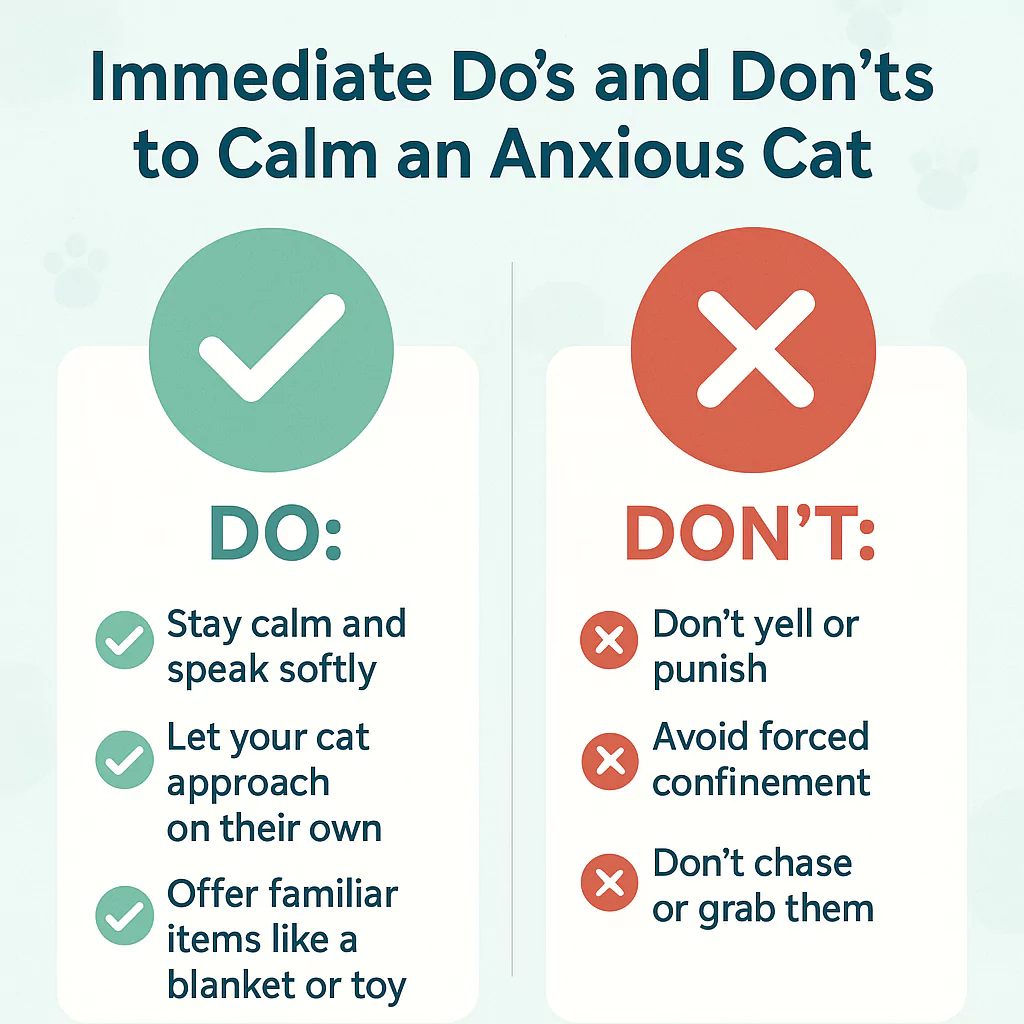
Do This
- Stay Calm and Use a Soft Tone: Cats are susceptible to human feelings. If you are anxious or emotionally charged, your cat will also feel this and mimic your energy. Use a soft tone to communicate, move slowly, and breathe deeply to communicate safety to your cat.
- Allow Your Cat to Come to You: Instead of reaching for or chasing your cat, try sitting down on their level and remaining still, allowing them to approach you when they are ready. This noninvasive way of introducing yourself helps build trust and can provide an anxious cat with a sense of control.
- Provide a Transitional Object: Place your cat’s favorite toy, blanket, or even a piece of clothing near them. Familiar scents can be soothing and help to stabilize an anxious cat.
- Use Calming Techniques: If your cat can tolerate touch, especially gentle stroking or a slow blink (the feline way of communicating trust) can calm them down. Or just being near without interaction is still supportive.
Don’t Do This
- Don’t Punish or Scold: An anxious cat isn’t “bad,” they’re coping. Punishing, scolding, yelling, or spraying your cat with water only heightens anxiety and damages the bond between you and your cat.
- Don’t Force a Confinement Space: Putting your cat in a carrier or crate can induce panic and the potential for self-injury (broken nails or bothering their teeth) and continue the cycle of fear for that location.
- Don’t Corner or Chase: Forcing a cat out of hiding or into your arms will not help improve anxiety. Let them stay in the safe space and approach when they choose to.
Creating a Calming Environment – Safe Zone (Short-Term Fixes)
Supporting your cat in feeling at ease in their environment is key to helping manage anxiety. Cats are creatures of habit, and the quality of their environment can mean the difference between a stressed pet and a calm, happy pet.
Whether your cat is reacting to sudden changes in their lives or has a known history of chronic anxiety conditions, creating the right environment at home provides a moment of relief from anxiety and an overall balance of peace in their emotional world.
Cozy Bedding
A cozy, warm resting spot provides instant security for your kitty. Making a cozy nesting area with some soft blankets, a preferred cushion, or a heated pad is a great way to do this. The goal of this area is to create a secure and welcoming place, especially during times of loud events or when new or unfamiliar people are present.
Covered Hiding Spots
Cats often look for privacy when they are feeling anxious. You can provide a place where they can hide by giving them an enclosed bed, a cardboard box, or access to a cupboard or closet. These spots offer enclosed nooks where cats can feel safe, similar to how cats in the wild hide in dens when they feel threatened.
Familiar Scents
Cats have an excellent sense of smell. Surrounding your cat with items like toys, blankets, or items that smell like you can provide comfort. Even if stressors are happening outside, the scent remains familiar. It reminds them that they still occupy a familiar space.
Pheromone Sprays or Diffusers
Synthetic pheromones like Feliway diffusers simulate the calming facial pheromones that cats naturally produce. Pheromones help reduce tension, often nearly instantly. Just spray carriers before travel, apply them to bedding, or plug in diffusers to stressful places.
Long-Term Support: Build a Stable, Enriching Environment
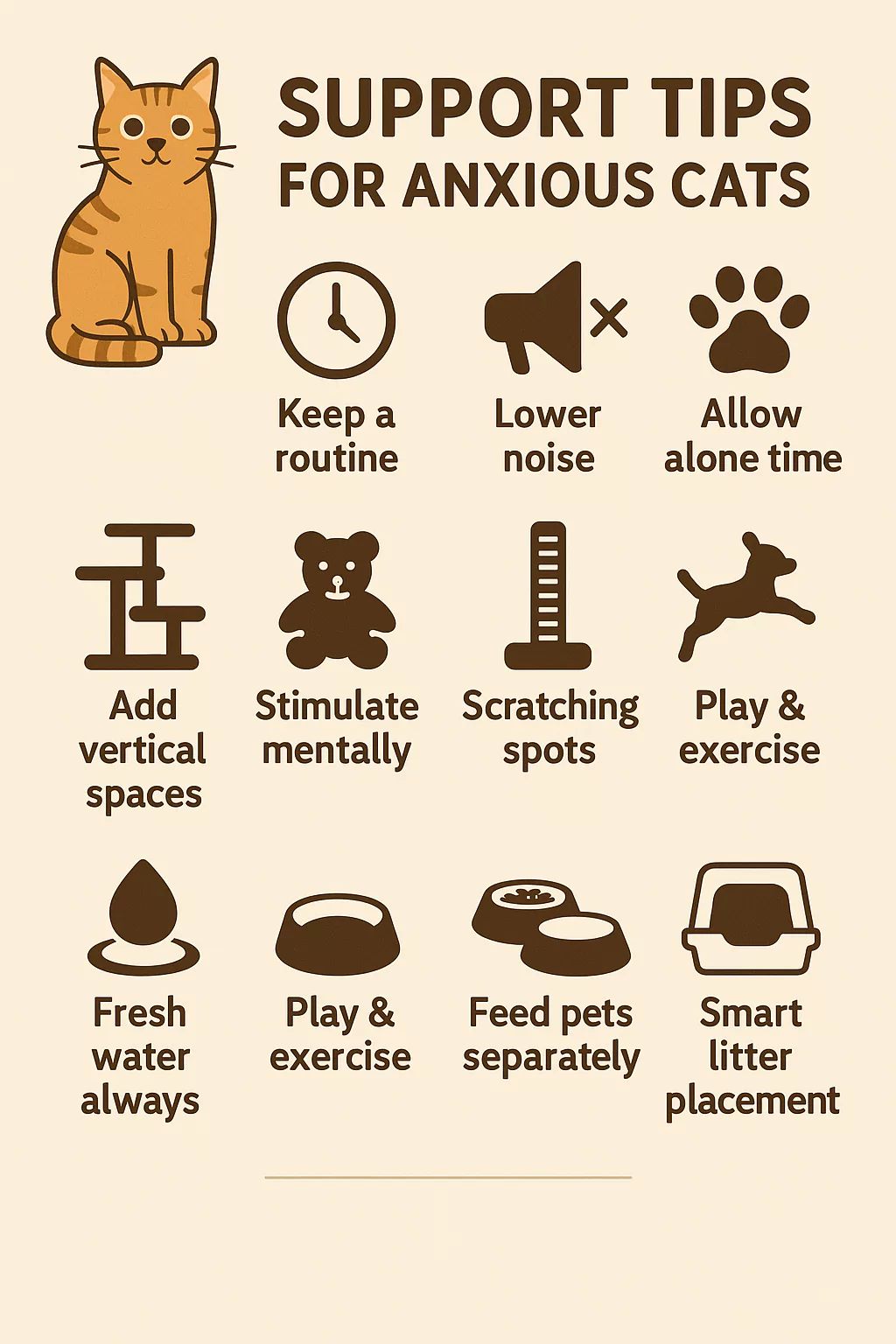
Provide Routine
Cats like predictability. Feeding, playing, and even cuddling at the same time each day give your cat a sense of control and security. Sudden changes in routine can be confusing and uncomfortable for cats, especially if they struggle with anxiety anyway.
Offer Vertical Territory
Cats are natural climbers and feel like they are safer when they can observe the world from above. Cat trees, a window shelf, and wall-mounted steps will give your cats vertical territory so they can feel mentally stimulated and protected. These vertical spots can also act as a retreat for when your cat is seeking solitude.
Reduce Noise
Loud noises like fireworks, vacuum cleaners, or boisterous guests can raise anxiety in cats. Always keep the volume low when you can, and think about low, calming music or white noise machines to create a calm environment. It is essential in houses with children or other pets.
Rethink About Litter Box Placement
An often-ignored stressor is the location of the litter box. The litter box should not be crammed in a corner or a place with only one point of entry so your cat feels trapped, especially if there are multiple pets in the home. The ideal situation is to have one litter box per cat plus one extra and to spread the litter boxes out throughout the house. If you have multiple floors, there should be one litter box for each floor.
Feed Each Pet Separately
Shared meal times can be anxiety-provoking for cats, especially if they feel they are being observed or challenged by another pet. To create a more harmonious eating situation, create separate feeding areas so that the pets can eat without being able to see each other. It helps reduce the opportunities for food guarding and helps reduce the stress and competition associated with eating.
Use Play & Exercise to Burn Off Anxiety
Restless cats can easily become nervous. Physical activity is an excellent release for pent-up stress. Please make use of daily playtime with wand toys, games of chase, and interactive puzzles that allow them to engage their natural hunting instincts. Tired cats tend to be calmer and more content, and they are less likely to respond with anxiousness when their environment changes.
Keep Fresh Water Access All Time
Cats might not normally drink large amounts of water, but they need clean, fresh water every day for health and comfort. Having multiple water stations in your home, such as a fun fountain, can prompt your cat to sip water throughout the day.
A hydrated cat is a happy cat or at least a less anxious cat. In general, expect a cat to drink about 4 oz of water per 5 lbs of body weight each day. Fresh water also alleviates anxiety around scarcity, especially in multi-cat homes. Try not to place water bowls next to the litter box or in loud environments. Provide wide bowls or a pet fountain if your cats are picky drinkers.
Give Your Cat Some “Alone Time”
Cats appreciate and enjoy their peace just like we do! Like us, they need a place where they can nap, hide, or hang out without interruptions. Create a quiet area or room for them to relax. Put a cat tree, soft bedding, or even a cardboard box for comfort. It will give them some comfort and security, especially in a busy or loud home.
Be mindful of their downtimes and let them come to you when they want to give you attention. A minor downtime can go a long way in reducing feelings of anxiety.
Set Up Multiple Scratching Spots
Scratching is more than a habit; your cat is using scratching as a tool to manage stress. By providing enough scratching-friendly options, you can help your cat feel secure and relaxed.
Choose different textures and angles, such as vertical posts, cardboard pads, or sisal mats. Once you have scratching options, scatter them throughout your home so they always have a healthy choice for the energy they need to release. It saves your furniture and gives your cat a safe, relieving way to stretch and calm an anxious cat.
Provide Mental Stimulation
Indoor boredom is often a source of anxiety for cats. Keep them mentally engaged and focused with puzzle feeders, wand toys, and different interactive games, and even rely on enrichment from watching birds through the window. Mental stimulation is just as vital as physical play to alleviate unnecessary stress.
Minimize Routine Disruptions
Familiarizing changes in the home, such as shifting furniture, new pets, or visitors, will seem like a frenzy to a cat. Changes should be made incrementally and can be made easier by allowing the cat to own their space. Allow the cat to explore at its own pace instead of being forced into socializing.
Enrichment & Mental Stimulation
While cats might appear to be low-maintenance pets, they need a regular source of mental and physical stimulation to stay emotionally balanced. When cats become under-stimulated, they often become anxious due to boredom, frustration, or pent-up energy.
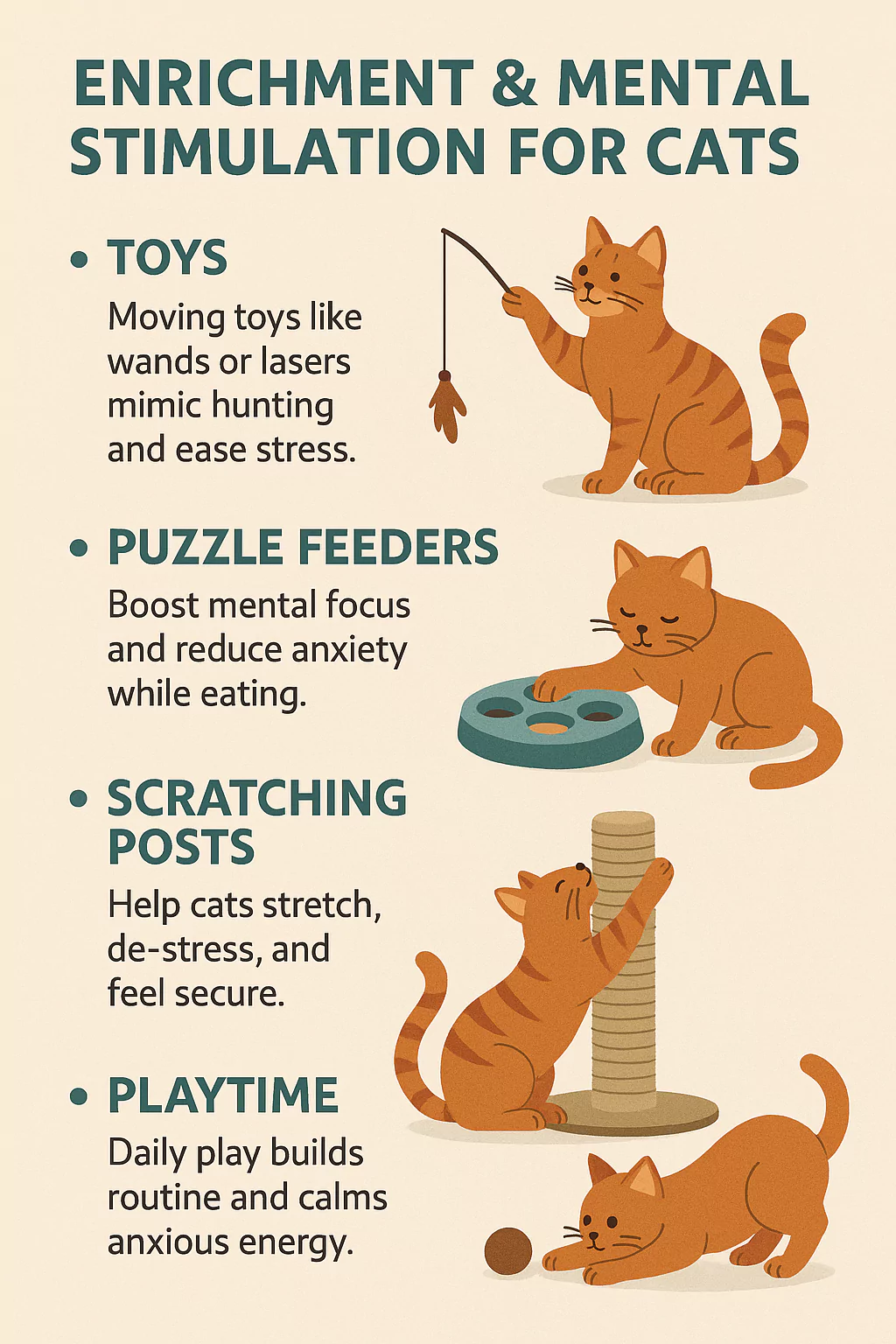
Why Enrichment Matters
In their natural habitat, cats do not simply lay around all day. Instead, they spend their days hunting for food, climbing, exploring their territory, and problem-solving. Living and sleeping inside all the time can easily become boring if we do not allow our cats healthy outlets.
Interactive Toys
Interactive toys (toys that move or interact with your cat’s touch) can help you maintain some semblance of those healthy hunting and play instincts. They have the added benefit of entertaining them while helping bring down boredom and anxiety. Depending on your cat’s play style, or their hunting style at the least, you may want feather wands, laser pointers, or even motorized mice.
Puzzle Feeders
Puzzle feeders give your cat a problem to solve while rewarding them with food or treats. Using a puzzle feeder also slows down your cat’s eating and promotes foraging and natural behaviors. It is also just a fun activity that keeps their brains engaged and decreases stress.
Cat Scratching Posts
Scratching posts offer cats a way to stretch, mark territory, and release pent-up energy. If you have multiple posts throughout the home, you are giving the cat healthy scratching options. Posts come in horizontal and vertical types, depending on the cat’s preference.
Scheduled Playtime
At the same time each day, play with your pet! Daily play also helps establish a routine that promotes a sense of security. Routine playtime also burns excess energy that could contribute to anxious behaviors. Consider interactive playtime in the morning and night for a good balance.
Observe and Adapt
Keep an eye out for changes in appetite, grooming, or social behavior. These could be some of the first clues to stress. Provide support as needed. For example, this could be more playtime, environmental changes, or calming solutions.
For more tips on how to create a mentally enriching and low-stress environment, check out the Indoor Pet Initiative by Ohio State University journal.
Calming Aids & Tools to Calm an Anxious Cat
Some calming products can provide additional assistance during stressful situations, such as vet visits or environmental changes. Pheromone diffusers such as Feliway, natural supplements such as L-theanine, and even calming diets that prevent some anxiety reactions can be very helpful. Compression vests and soft music can also help ease the anxieties of sensitive, stressed cats.
Pheromones
Synthetic pheromones, such as Feliway, mimic the comforting scents released naturally by cats. These diffusers or sprays can calm stressed cats in stressful situations, as well as reduce marking behaviors or aggression. You can use pheromones in the carriers a kitty travels in, the safe zones of cats like in a crate, or high traffic of cats like home offices or cat microplans.
Natural Supplements
Nutritional aids such as L-theanine (Anxitane), Zylkene, and calming diets help do the work of reducing stress without sedation effects. They help with brain health and create improved relaxation over time. Always check with your veterinary professional before pursuing regular use of any product, including supplements.
Compression Vests
Compression vests, such as ThunderShirts, provide gentle, constant pressure on your cats to make them feel secure. They can be invaluable during storm visits to the veterinarian or when traveling in a vehicle. You will want to introduce them slowly over time so that your cat is comfortable adjusting to the vest.
Sound Therapy
Soft music, white noise machines, or sleep/playlists approved by the veterinarian can help mask sounds that may be loud or triggering. By introducing music, it creates a calm setting with a soothing background. It is a perfect thing to play during times of the year when anxiety is likely to occur, like fireworks or thunderstorms.
With expert recommendations available for effective cat-calming products, selecting practical calming tools such as pheromone collars, diffusers, or Thundershirts becomes easier.
Behavior Modification to Calm an Anxious Cat
Helping your anxious cat feel safe around their triggers will take time and patience. You can use desensitization and counterconditioning that will gradually diminish how scary the things that trigger the anxiety are with a little bit of reward and a little bit of gentle exposure. You want to consistently reward calm behavior and build trust so they can learn more healthy responses.
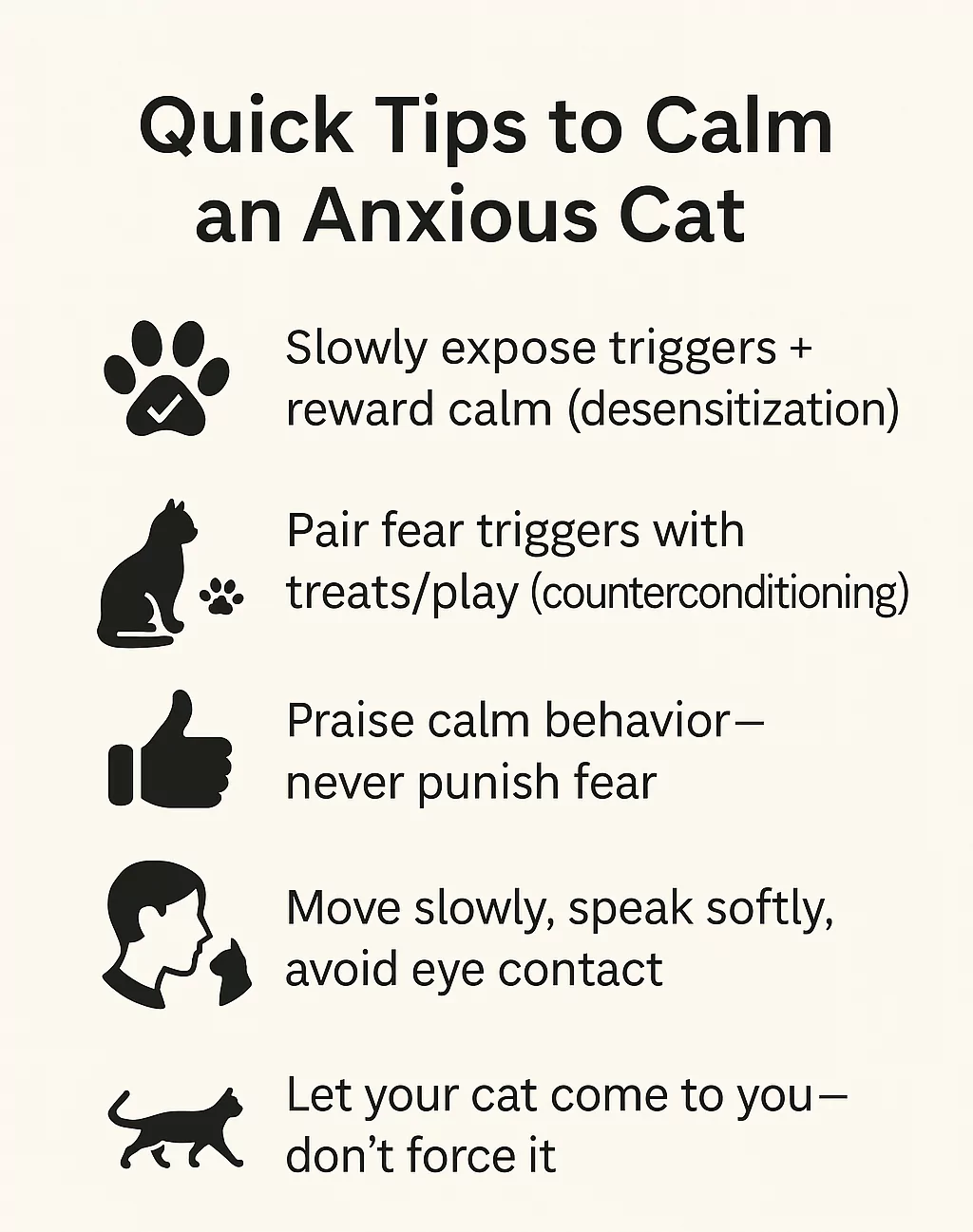
Desensitization
Gradual exposure to low-intensity fear triggers can help cats develop tolerance. Over time, they learn that the trigger is not dangerous. It is essential to go slow and reward calm behavior to avoid setbacks.
Counterconditioning
When the anxiety trigger is paired with a positive experience, this changes the way the cat perceives the stressor. Provide the cat with treats, praise, or play immediately after exposure to a stressor. It builds a new, positive association with that trigger.
While counterconditioning, you may notice that your cat is kneading or purring – these are behaviors that typically signify relaxation and comfort. Learn more about why my cat kneads. And the significance of emotional comfort.
Positive Reinforcement
Always reward the calm and relaxed behaviors of your cat. Over time, they may be more inclined to repeat those behaviors to earn praise or treats. Do not punish the cat for fearful responses, as this will only increase anxiety.
Handling & De-escalation Techniques
When your cat is anxious, remember to move very slowly, talk to them softly, and let them come to you. Avoid direct eye contact, sudden movements, or forcing them to be petted – these things can build fear. Allow the opportunity for space and respect their boundaries. Showing they can have space and that you are a safe, calming presence.
Take Your Time and Stay Low
When your cat is nervous or anxious, the sudden movement creates fear. Move slowly, speak softly so cats do not see you as threatening, and give them a chance to relax.
Give Them Space
Please do not force them to interact when they are stressed. Let them come to you when they are ready. Slow, deep breaths with a calm presence can help reassure them.
Do Not Punish or Force
Never punish or restrain a scared cat; it destroys trust and escalates fear. Forcing contact may make your cat aggressive or may be very traumatizing for cats. Instead, offer supporting calm energy and patience.
Travel & Situational Stress
Travel and sudden shifts in a cat’s environment can cause substantial anxiety, even in otherwise relaxed cats.
You may have an otherwise calm and happy feline, but traveling with them to the vet, having guests over, or moving homes can spark intense anxiety in them.
All of these examples of interruptions can cause psychological distress to your cat and make them feel insecure and on high alert.
Suppose you can follow your cat’s cues and stressors and engineer solutions ahead of time.
In that case, you can minimize the stress level of the situation and maintain or reestablish your cat’s sense of safety in an ongoing sense of uncertainty.
Carrier Acclimation
Most cats dislike a carrier unless it becomes a part of their standard setting. Once you have an appropriate carrier, you can leave the carrier out with soft bedding, a familiar smell, and even treats so your cat feels safe inside. Over time, your cat may enter on their own–making it a source of comfort rather than fear.
Vet Visit Preparation
Before you take your cat to the vet, spray the inside of the carrier with feline pheromones like Feliway for 15–30 minutes to load your cat in the carrier to reduce emotional stress. You may want to cover the carrier with a light towel to help minimize visual stress and speak calmly through the journey to assist with your cat’s stress.
Home Transitions
Relocating, remodeling, and new additions can all be a lot for us and for our kitties, too. Create a private, “safe room” for your cat with food, litter, toys, and familiar smells so they can hide and decompress at their own pace.
Veterinary & Professional Support
If you’ve done everything you can at home and the environment changes and it has still not worked to calm an anxious cat, it’s time to reach out for professional help. Chronic or severe cases of anxiety in cats often warrant veterinary intervention to assess for medical causes and prepare a suitable treatment plan.
A veterinarian or animal behaviorist can provide medical treatment and behavioral modifications to put your cat’s emotions back in focus.
When to Consult a Professional
If your cat’s anxiety is not changing with home strategies or is getting worse, speak to your veterinarian or a certified feline behaviorist. They can assess for further medical or behavioral assistance.
Medication Options
Some cats may require anti-anxiety medications. For short-term stressors, benzodiazepines are used. Selective-serotonin reuptake inhibitors (SSRIs) are the long-term option for chronic anxiety, as in fluoxetine. These treatments must be prescribed and monitored by your veterinarian.
Customized Treatment Plans
No two cats are the same. Your veterinarian will modify medication dosages, therapy methods, or enrichment activities related to your cat’s progress. Routine follow-ups help ensure that your cat is receiving the best possible and most compassionate care.
Diagnosis for Underlying Medical Problems of Anxious Cat
If your cat seems to show anxiety more often than not or if their behavior suddenly shifts without any reason, it may be time to employ the help of a professional.
While anxiety may seem to be behavioral in itself, there may be much overlap with underlying medical problems. That is where your veterinarian can help.
Let’s discover how vets assist in determining the source of feline anxiety before directing you toward the treatment.
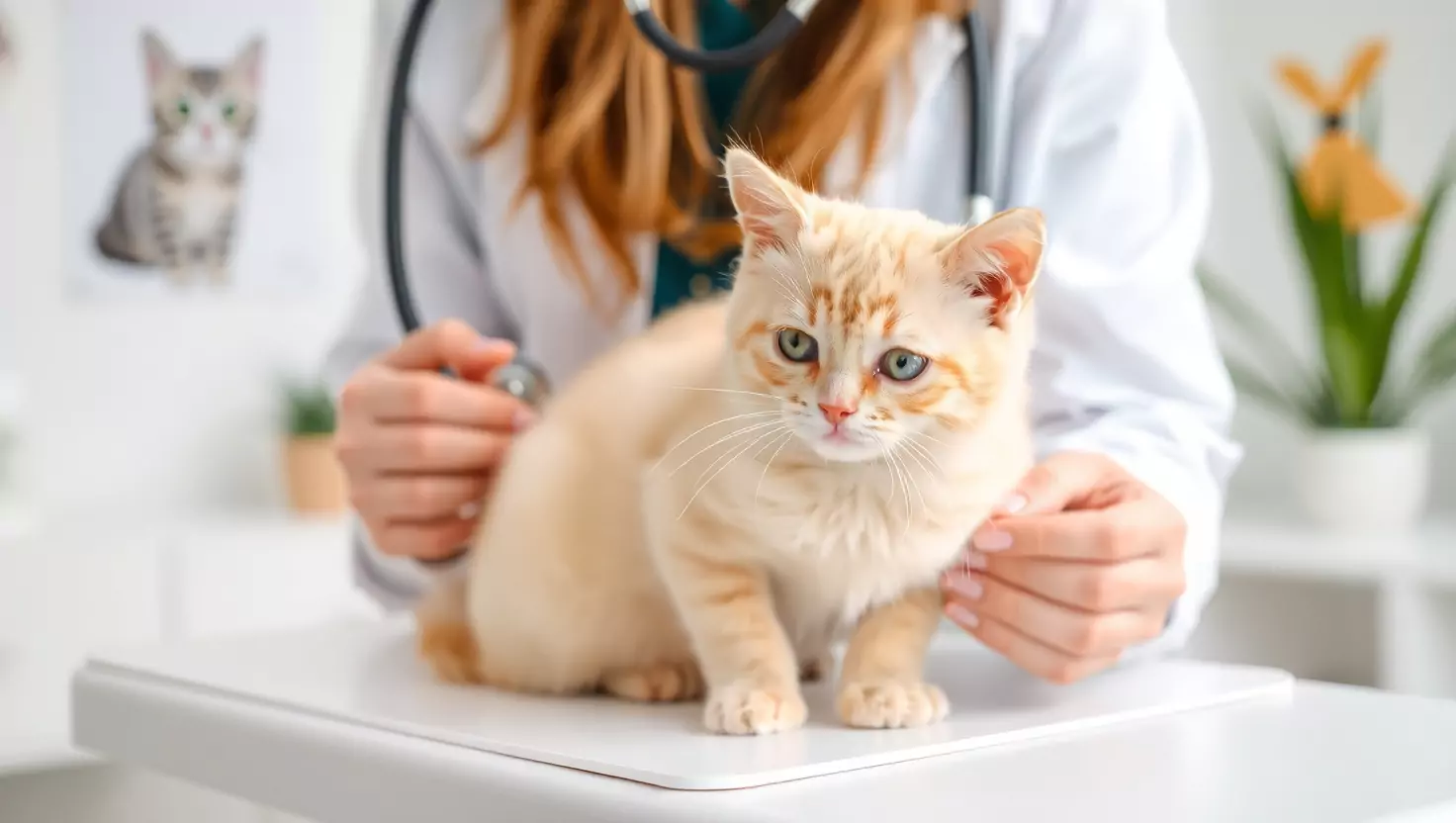
Step 1: Physical Exam and Medical Screening
The first thing your veterinarian will do is rule out any physical health problems that may be causing or aggravating your cat’s anxiety. Even little health problems can cause significant behavioral changes in cats.
Here is what the vet will typically check
- Complete physical exam: A focused physical exam is helpful to identify areas of pain, skin irritation, or stiffness. Blood Test (CBC, thyroid panel): The blood Test looks to rule out issues such as hyperthyroidism, an infection, or changes to an organ’s function.
- Urinalysis: This is especially important for urinary tract infections, kidney problems, or cystitis related to stress.
- Many medical issues that cats suffer (e.g., dental disease, digestive pain, and arthritis) will go unnoticed by pet owners – but can often create significant stress for cats. That’s why it is best not to skip having a veterinarian assess your pet.
Step 2: Behavioral History and Observations
Assuming that your cat has received a clean bill of health from the veterinarian, the next step is behavior analysis. This step examines:
- Everything you have witnessed in your home
- References of your cat’s behavior videos (this is useful in particular!)
- Details about when and where the anxiety occurs
- Changes in your routine, home environment, or social structure.
Your veterinarian may ask:
- “When did this behavior first start?”
- “Have you had any changes at home recently?”
- “What is the most common trigger that leads to anxious behavior?”
It is a critical step because cats are extremely private animals. By carefully putting the pattern together, your veterinarian can differentiate between normal cat behavior and anxiety that needs to be looked at.
Collaborative Approach
In some cases, your regular vet may refer you to a veterinary behaviorist – a specialist in feline mental health. These specialists can help you develop an individualized treatment plan that may include changes to the environment, behavior modification, and, potentially, medication.
Think of it as teamwork: your observations + your vet’s clinical knowledge = a clearer description of your cat’s needs.
Preventing Anxiety Before It Starts
In my experience, the most effective method of dealing with current cat anxiety is to prevent it from occurring in the first place. Early socialization, positive experiences, and a stable environment are all essential ways to build a confident, emotionally secure cat.
By understanding the needs of your kitten from the start and investing trust in them by taking gentle steps to expose them) them to new things while opting to respect their needs, you can build a solid foundation for them to be a calm and well-adjusted cat!
Choosing a Well-Socialized Kitten
A confident and curious kitten who has been gently handled and exposed to a home environment since they were young will be less likely to develop anxiety. If you are adopting a kitten, ask them about their socialization history.
Positive Exposure Early On
From 7-14 weeks, allow your kitten to experience everyday household noises (vacuums, doorbells), exposure to many different people, and being handled by humans gently. Keep the experiences short, calm, and positive; this builds resilience.
Respect Their Pace
Always allow cats to explore new environments and new people at their own pace. Never force contact or hold your kitten down against their will. It causes fear and trust issues.
FAQs
How do I know if my cat is anxious or just shy?
Not all quiet cats are anxious, but there are some clear signs to pay attention to. If your cat is seeking more hiding places, avoiding eye contact, or startling more easily than usual, it could be more than shyness. Look for new behaviors, including pacing, excessive grooming, tail flicking, or going outside the litter box. These behaviors may indicate stress. Noticing these behaviors is the first step in knowing how to effectively and gently calm an anxious cat.
What’s the best way to calm an anxious cat at home?
First, find a safe, quiet spot where your cat feels secure – this could be a small room with a blanket, some toys, a litter box, etc. Use feline pheromone diffusers, and be sure to keep the habits of your daily routines the same. Start by lightly engaging your cat in play and provide “safe” hiding spots or vertical surfaces such as a cat tree. If you are looking for how to calm an anxious cat, staying consistent with an enriched environment is key.
Can changes in my home make my cat anxious?
Absolutely. Sudden changes or exposure to new stimuli (people, noise, furniture) can cause anxiety in cats. Cats are habitual animals and often act quite differently when they smell, hear, or experience a change in their routine. To help reduce anxiety exposure, avoid sudden changes and try to maintain familiarity (familiar places!). If you are figuring out how to calm an anxious cat, controlling their environment is a crucial process.
When should I seek veterinary help for my cat’s anxiety?
If your cat’s anxiety hasn’t improved with home strategies (safe spaces, play therapy, calming tools), it’s time to contact your veterinarian. They will be able to rule out medical problems and may consider medications or refer you to a veterinary behaviorist. When you want to calm an anxious cat with more complex emotional needs, you need professional assistance.
Conclusion
Cat anxiety might seem overwhelming, but with the right strategy, support, and consistency, calm is possible. From making a cozy, safe space to applying calming tools and behavior techniques, there are loads of gentle ways to ease stress for your cat. Learning how to calm an anxious cat doesn’t just mean managing symptoms; it means developing trust, safety, and a state of happiness in your home.
By remaining calm and observant, you’re not only relieving an anxious state, but you’re also nurturing a bond with your cat that can last their entire life. So breathe, follow these easy highlighted steps, and allow your cat to explore once again their calm and confident self, one purr at a time.

